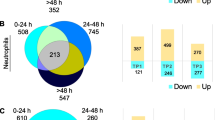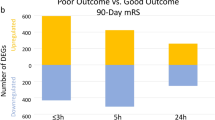Abstract
Our group recently identified a panel of ten genes whose RNA expression levels in whole blood have utility for detection of stroke. The purpose of this study was to determine the mechanisms by which these genes become differentially expressed during stroke pathology. First, we assessed the transcriptional distribution of the ten genes across the peripheral immune system by measuring their expression levels on isolated neutrophils, monocytes, B-lymphocytes, CD-4+ T-lymphocytes, CD-8+ T-lymphocytes, and NK-cells generated from the blood of healthy donors (n = 3). Then, we examined the relationship between the whole-blood expression levels of the ten genes and white blood cell counts in a cohort of acute ischemic stroke patients (n = 36) and acute stroke mimics (n = 15) recruited at emergency department admission. All ten genes displayed strong patterns of lineage-specific expression in our analysis of isolated leukocytes, and their whole-blood expression levels were correlated with white blood cell differential across the total patient population, suggesting that many of them are likely differentially expressed in whole blood during stroke as an artifact of stroke-induced shifts in leukocyte counts. Specifically, factor analysis inferred that over 50% of the collective variance in their whole-blood expression levels across the patient population was driven by underlying variance in white blood cell counts alone. However, the cumulative expression levels of the ten genes displayed a superior ability to discriminate between stroke patients and stroke mimics relative to white blood cell differential, suggesting that additional less prominent factors influence their expression levels which add to their diagnostic utility. These findings not only provide insight regarding this particular panel of ten genes, but also into the results of prior stroke transcriptomics studies performed in whole blood.




Similar content being viewed by others
References
Tang Y, Xu H, Du X, Lit L, Walker W, Lu A, et al. Gene expression in blood changes rapidly in neutrophils and monocytes after ischemic stroke in humans: a microarray study. J Cereb Blood Flow Metab Off J Int Soc Cereb Blood Flow Metab. 2006;26:1089–102.
Stamova B, Xu H, Jickling G, Bushnell C, Tian Y, Ander BP, et al. Gene expression profiling of blood for the prediction of ischemic stroke. Stroke J Cereb Circ. 2010;41:2171–7.
O’Connell GC, Petrone AB, Treadway MB, Tennant CS, Lucke-Wold N, Chantler PD, et al. Machine-learning approach identifies a pattern of gene expression in peripheral blood that can accurately detect ischaemic stroke. Npj Genomic Med. 2016;1:16038–8.
Raman K, O’Donnell MJ, Czlonkowska A, Duarte YC, Lopez-Jaramillo P, Peñaherrera E, et al. Peripheral blood MCEMP1 gene expression as a biomarker for stroke prognosis. Stroke J Cereb Circ. 2016;47:652–8.
Barr TL, Conley Y, Ding J, Dillman a, Warach S, Singleton a, et al. Genomic biomarkers and cellular pathways of ischemic stroke by RNA gene expression profiling. Neurology 2010;75:1009–1014.
O’Connell GC, Chantler PD, Barr TL. Stroke-associated pattern of gene expression previously identified by machine-learning is diagnostically robust in an independent patient population. Genomics Data. 2017;14:47–52.
Chamorro Á, Meisel A, Planas AM, Urra X, van de Beek D, Veltkamp R. The immunology of acute stroke. Nat Rev Neurol. 2012;8:401–10.
Iadecola C, Anrather J. The immunology of stroke: from mechanisms to translation. Nat Med. 2011;17:796–808.
Macrez R, Ali C, Toutirais O, Le Mauff B, Defer G, Dirnagl U, et al. Stroke and the immune system: from pathophysiology to new therapeutic strategies. Lancet Neurol. 2011;10:471–80.
Urra X, Cervera Á, Obach V, Climent N, Planas AM, Chamorro A. Monocytes are major players in the prognosis and risk of infection after acute stroke. Stroke. 2009;40:1262–8.
Vogelgesang A, Grunwald U, Langner S, Jack R, Bröker BM, Kessler C, et al. Analysis of lymphocyte subsets in patients with stroke and their influence on infection after stroke. Stroke. 2008;39:237–41.
Guo Z, Yu S, Xiao L, Chen X, Ye R, Zheng P, et al. Dynamic change of neutrophil to lymphocyte ratio and hemorrhagic transformation after thrombolysis in stroke. J Neuroinflammation. 2016;13:199–9.
Rosell A, Cuadrado E, Ortega-Aznar A, Hernández-Guillamon M, Lo EH, Montaner J. MMP-9-positive neutrophil infiltration is associated to blood-brain barrier breakdown and basal lamina type IV collagen degradation during hemorrhagic transformation after human ischemic stroke. Stroke. 2008;39:1121–6.
Maestrini I, Strbian D, Gautier S, Haapaniemi E, Moulin S, Sairanen T, et al. Higher neutrophil counts before thrombolysis for cerebral ischemia predict worse outcomes. Neurology. 2015;85(16):1408–16.
Urra X, Cervera Á, Villamor N, Planas a M, Chamorro Á. Harms and benefits of lymphocyte subpopulations in patients with acute stroke. Neuroscience. 2009;158:1174–83.
Abbas a R, Baldwin D, Ma Y, Ouyang W, Gurney a MF, et al. Immune response in silico (IRIS): immune-specific genes identified from a compendium of microarray expression data. Genes Immun. 2005;6:319–31.
Whitney AR, Diehn M, Popper SJ, Alizadeh AA, Boldrick JC, Relman DA, et al. Individuality and variation in gene expression patterns in human blood. Proc Natl Acad Sci U A. 2003;100:1896–901.
Kidwell CS, Warach S. Acute ischemic cerebrovascular syndrome: diagnostic criteria. Stroke. 2003;34:2995–8.
Bamford J, Sandercock P, Dennis M, Burn J, Warlow C. Classification and natural history of clinically identifiable subtypes of cerebral infarction. Lancet Lond Engl. 1991;337:1521–6.
Lee LJ, Kidwell CS, Alger J, Starkman S, Saver JL. Impact on stroke subtype diagnosis of early diffusion-weighted magnetic resonance imaging and magnetic resonance angiography. Stroke. 2000;31:1081–9.
Heckmann L-H, Sørensen PB, Krogh PH, Sørensen JG. NORMA-gene: a simple and robust method for qPCR normalization based on target gene data. BMC Bioinformatics. 2011;12:250–0.
O’Connell GC, Treadway MB, Petrone AB, Tennant CS, Lucke-Wold N, Chantler PD, et al. Leukocyte dynamics influence reference gene stability in whole blood: data-driven qRT-PCR normalization is a robust alternative for measurement of transcriptional biomarkers. Lab Med. 2017;48:346–56.
Ross I, Robert G, Ihaka R, Gentleman R. R: a language for data analysis and graphics. J Comput Graph Stat. 1996;5:299–314.
Robin X, Turck N, Hainard A, Tiberti N, Lisacek F, Sanchez J-C, et al. pROC: an open-source package for R and S+ to analyze and compare ROC curves. BMC Bioinformatics. 2011;12:1–8.
Venables WN, Ripley BD. Modern applied statistics with S [Internet]. Springer New York: New York, NY; 2002. Available from: http://www.stats.ox.ac.uk/pub/MASS4
DeLong ER, DeLong DM, Clarke-Pearson DL. Comparing the areas under two or more correlated receiver operating characteristic curves: a nonparametric approach. Biometrics. 1988;44:837–45.
Benjamini Y, Hochberg Y. Controlling the false discovery rate: a practical and powerful approach to multiple testing. J R Stat Soc. 1995:289–300.
Droste A, Sorg C, Högger P. Shedding of CD163, a novel regulatory mechanism for a member of the scavenger receptor cysteine-rich family. Biochem Biophys Res Commun. 1999;256:110–3.
O’Connell GC, Tennant CS, Lucke-Wold N, Kabbani Y, Tarabishy AR, Chantler PD, et al. Monocyte-lymphocyte cross-communication via soluble CD163 directly links innate immune system activation and adaptive immune system suppression following ischemic stroke. Sci Rep. 2017;7:12940–0.
Leclerc JL, Lampert AS, Loyola Amador C, Schlakman B, Vasilopoulos T, Svendsen P, et al. The absence of the CD163 receptor has distinct temporal influences on intracerebral hemorrhage outcomes. J Cereb Blood Flow Metab. 2017;0271678X1770145-0271678X1770145.
Liu R, Cao S, Hua Y, Keep RF, Huang Y, Xi G. CD163 expression in neurons after experimental intracerebral hemorrhage. Stroke. 2017;48:1369–75.
Petrone AB, O’Connell GC, Regier MD, Chantler PD, Simpkins JW, Barr TL. The role of arginase 1 in post-stroke immunosuppression and ischemic stroke severity. Transl Stroke Res. 2016;7:103–10.
Jickling GC, Ander BP, Zhan X, Noblett D, Stamova B, Liu D. MicroRNA expression in peripheral blood cells following acute ischemic stroke and their predicted gene targets. PLoS One. 2014;9:e99283.
Dykstra-Aiello C, Jickling GC, Ander BP, Shroff N, Zhan X, Liu D, et al. Altered expression of long noncoding RNAs in blood after ischemic stroke and proximity to putative stroke risk loci. 2016.
Acknowledgments
The authors would foremost like to thank the subjects and their families, as this work was truly made possible by their selfless contribution. In addition, we would like to thank the stroke team at Ruby Memorial Hospital for supporting this research effort.
Funding
Work was funded via a Robert Wood Johnson Foundation Nurse Faculty Scholar award to TLB (70319), a National Institutes of Health CoBRE sub-award to TLB (P20 GM109098), and Case Western Reserve University FPB School of Nursing start-up funds issued to GCO.
Author information
Authors and Affiliations
Corresponding author
Ethics declarations
Procedures were approved by the institutional review boards of West Virginia University and Ruby Memorial Hospital (IRB protocol 1410450461R001), and written informed consent was obtained from all subjects or their authorized representatives prior to study procedures.
Conflict of Interest
GCO and TLB have a patent pending re: genomic patterns of expression for stroke diagnosis. TLB serves as chief scientific officer for Valtari Bio Incorporated. Work by GCO is part of a pending licensing agreement with Valtari Bio Incorporated. GCO has received consulting fees from Valtari Bio Incorporated. The remaining authors report no potential conflicts of interest.
Electronic supplementary material
ESM 1
(PDF 1655 kb)
Rights and permissions
About this article
Cite this article
O’Connell, G.C., Treadway, M.B., Tennant, C.S. et al. Shifts in Leukocyte Counts Drive the Differential Expression of Transcriptional Stroke Biomarkers in Whole Blood. Transl. Stroke Res. 10, 26–35 (2019). https://doi.org/10.1007/s12975-018-0623-1
Received:
Revised:
Accepted:
Published:
Issue Date:
DOI: https://doi.org/10.1007/s12975-018-0623-1




